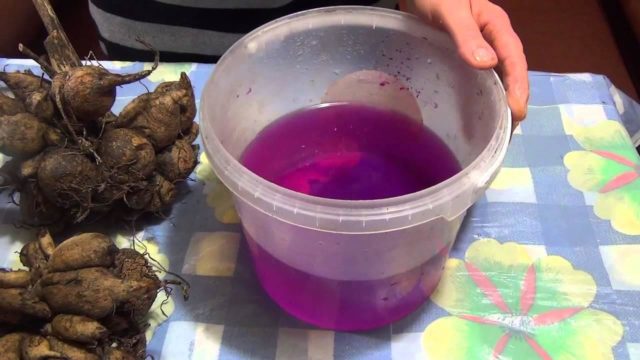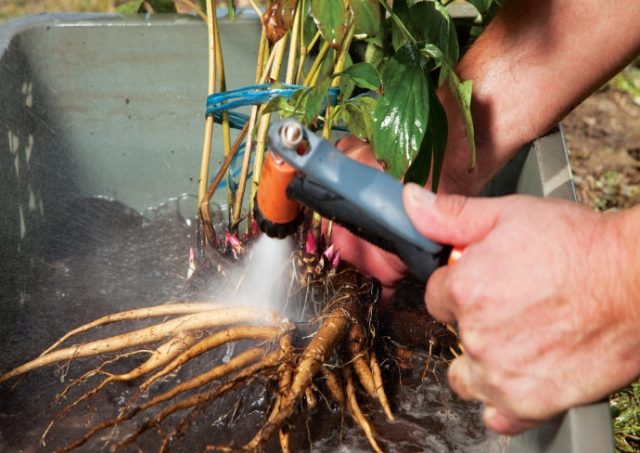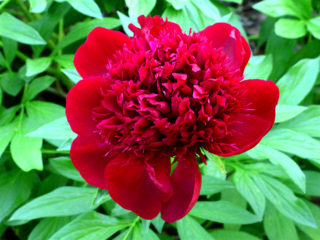Content
Peony Team Performance belongs to the new generation of hybrids. He quickly won the hearts of flower growers with his long and abundant flowering. Not only the inflorescences are beautiful, but also the bright foliage. Performance peony bushes are a worthy decoration for any flower bed.
Description of peony Team Performance
In the late 90s, breeders introduced a new peony hybrid, the bushes of which quickly captivated the public. The variety has won many awards and taken a leading place among large-flowered varieties. In 1998, he became a grand champion at an exhibition in the USA.
Team Performance peony bushes are spreading, the shoots are strong and erect, but in some cases they may be deviated. Their lower part is bare. The height of an adult plant reaches 80 cm; supports are required when growing. The crown is spherical and can reach 1 m in diameter. The leaves are rich green, carved. The crop grows quickly, so when planting you need to leave enough space between the bushes. This will make caring for the massive plant easier.
The description of the hybrid states that Team Performance belongs to the light-loving varieties.However, it is worth considering that planting in an open sunny area significantly shortens the flowering time. The inflorescences quickly fade in direct sunlight, and the petals lose their bright color. It is best to set aside an area for the peony where the bush will be illuminated in the morning and afternoon.
The advantage of this hybrid is the high winter hardiness of the bushes. The rhizomes of the plant can safely withstand temperatures down to -40°C. That is why peony can be grown in any region of the country.
Features of flowering
Team Performance is a herbaceous hybrid with large double inflorescences, their diameter reaches 23-25 cm. Only one bud is formed on a high peduncle; there are no lateral ones. Flower hats are durable, elastic, and look like a pom-pom. The petals are tightly pressed to each other, slightly dissected at the top. The color of the flower is rich red with a slight coral tint. Peony does not have a strong aroma; there is a slightly perceptible subtle smell.

The inflorescences of this variety are very dense and are not afraid of rain.
Most sources indicate that the Team Performance hybrid belongs to the early varieties in terms of flowering time. In the southern regions, the first inflorescences bloom at the beginning of May, full flowering occurs in the middle of the month. In Moscow and the Moscow region, peony will delight you with lush caps in the second ten days of June. Flowering will continue for a month.
The large-flowered hybrid is widely grown for industrial cutting. The buds do not fall off and retain their presentation for a long time. However, for lush flowering, the shrub needs nutritious soil and timely fertilizing.
Application in design
Hybrid Team Performance, like all tall peonies, cannot be planted next to other large plants. A fight for territory and water quickly arises between them. In landscape design, large-flowered shrubs do not need additional decoration; they are planted singly, in small groups, or as a border.
Team Performance peonies look very beautiful during the flowering period, but after flowering the monotonous carved foliage needs to be covered. In the neighborhood it is good to plant plants with whole leaves that bloom later. Good fit:
- irises;
Delicate inflorescences are combined with large peony caps Team Performance
daylilies;Simple varieties of daylilies look good with terry peonies
hosts.It is better to plant hostas with bright foliage next to Team Performance
All of them will keep you company and create the necessary background throughout the summer.
Next to the round peony caps, the vertical inflorescences of mantle and foxglove look good. In terms of flowering time, they coincide with Team Performance and complement it well.

Lupine in a successful combination with the Command Performance variety
To create a harmonious composition, the lower part of the tall Team Performance peonies must be covered with suitable plants. In landscape design, low-growing and groundcover perennials are most often used. Looks remarkable:
- asters;
Thanks to their lush bushes, low-growing asters are suitable for planting in the foreground
heuchera;The culture grows slowly, so it can cover the bare peony stems for a long time
cuff;Spreading bushes with brightly colored foliage are a good company for the foreground of tall shrubs
primrose;While Team Performance peonies are just waking up, primroses are already actively blooming and decorating the flowerbed
geranium.Prefers sunny places and does not cause much trouble
These plants not only cover the unsightly part of the bush, but also create an additional background at a time when the peony has already faded.
Reproduction methods
You can propagate a peony bush in several ways:
- dividing the rhizome during transplantation;
The tubers are separated with a sharp instrument, the sections are sprinkled with ash
cuttings;Prepared cuttings are planted in a shaded place
- layering;
Only completely healthy bushes are spudded
seeds.Collecting peony seeds from Team Performance is difficult, varietal characteristics are not preserved
However, cuttings and seed propagation are too difficult. Most often, gardeners propagate shrubs by dividing the rhizomes. To do this, you need to dig up an adult plant and separate parts of the tubers with eyes.
In order not to injure the Team Performance peony by transplanting and digging, it is easier to propagate it by layering. In autumn, the bush is dug up and hilled high, some of the stems are underground. In the spring, new shoots will emerge from the dormant buds, which can be separated and planted in another place. Young plants fully retain varietal characteristics. It is better to practice this method of propagation on bushes that are 5-8 years old.
Landing rules
Peony Team Performance prefers well-drained soil, as it does not tolerate stagnant moisture at the roots. Soil that is too oily and nutritious is not suitable; it is best to give preference to loam. Loose soil is not suitable for this shrub; the roots need good support.
You need to approach the choice of a place for a peony responsibly, since it does not like transplants.They injure the perennial, it begins to get sick and may even die. Ideally, Team Performance is located in partial shade, where it will be protected from the scorching midday sun. You cannot plant the rhizome close to a fence or other buildings; the bush must develop well and freely. However, it is worth considering that drafts and cold winds are contraindicated for peony, so choose a protected area.
The selected location is prepared in advance. Since autumn, the soil has been dug deeply, flavored with humus or compost. Mineral fertilizers are not applied to the peony.
It is better to plant the Team Performance rhizome at the end of August or the very beginning of September, then during the autumn and winter the plant will take root well and will delight you with flowering in the spring. However, in regions with a warm climate, planting is allowed in early March or April, when the soil warms up to a temperature of +8 ... +10°C.
The acquired rhizomes are not ready for planting, so it is worth carrying out a number of procedures:
- Carefully inspect the tubers, remove all spoiled and damaged areas with a sharp knife.
It is important to remove rotten areas to healthy tissue
- Make cuts at an angle of 45°, then treat them with crushed activated carbon to prevent the development of fungal diseases.
You can completely dust the rhizomes with wood ash
- Place the roots in a solution of any fungicide for 15 minutes, then rinse under running water.
When there are no branded drugs at hand, it is better to use a solution of potassium permanganate
- Soak the tubers in clean water for 10-12 hours before planting.
Before starting the procedure, it is better to rinse the roots well under running water.
Such measures activate the natural forces of the bush and stimulate root growth.
The description states that there are no special features in the planting of the Command Performance peony.It is enough to remember that between the bushes you need to leave space for development. Planting holes are made at a distance of 70-100 cm. The depth of the holes is about 50-60 cm. The bottom must be drained so that excess moisture does not accumulate. During planting, the divisions are buried, the buds should be underground at a level of 3-5 cm. This will protect them from freezing.
Aftercare
Caring for Team Performance peony comes down to regular watering and fertilizing. The soil needs to be moistened so that the moisture saturates the entire earthen lump, however, the planting site cannot be turned into a swamp.
It is better to fertilize shrubs with phosphorus-potassium mixtures, humus or compost. Feeding is done several times a season, starting in early spring. As soon as the soil thaws, it is well loosened and humus is added. 2-3 weeks before the start of flowering, they switch to ash and other phosphorus-potassium fertilizers. In autumn, the bush is well covered with compost, which serves as the final feeding.
As the Team Performance peony grows, the shoots stretch upward, the bush expands, and some buds come to the surface. This should not be allowed, otherwise they will suffer from severe frosts in winter. In autumn, the tree trunk circle is well loosened and mulched with a high layer of humus or compost.
Throughout the growing season, rhizomes must receive not only nutrients, but also oxygen. To do this, the soil around the bushes must be regularly loosened and freed from weeds. The procedure is carried out carefully so as not to damage the kidneys.
Preparing for winter
At the end of summer, the Commander Performance peony needs to be given attention and the bush prepared for winter. The last time fertilizing is done is in mid-September using phosphorus-potassium mixtures.This will help the bushes recover after flowering, replenish their supply of nutrients and successfully overwinter.
With the onset of stable cold weather, the shoots are cut off, leaving 5-7 cm above the soil surface. The tree trunk circle is mulched with a thick layer of humus, peat or compost. In winter, the bushes are additionally insulated with snow, which is specially raked from the paths. In early spring, the cover is removed so that the shoots and roots do not have time to dry out.
Pests and diseases
The description of the Team Performance peony indicates that the variety is resistant to major diseases and pests. However, with inept care, troubles can happen. To avoid fungal infections, you need to promptly remove faded buds and spray the plant with copper sulfate for prevention. Treatment is carried out in early spring before budding and flowering.
Among the pests, Team Performance peonies are bothered by garden ants, which spread aphids to young leaves and buds. It feeds on the cell sap of the plant, flowering is delayed, and the bush gradually weakens. Ants and aphids must be dealt with immediately. To reduce the number of pests, beneficial insects, such as ladybugs, are attracted to the garden and eat them. You can spray the bush with complex insecticides.
Conclusion
Peony Team Performance is a large-flowered shrub with lush inflorescences, which occupies a leading position on the market. It can be grown in any corner of the country, the plant is not afraid of frost, and its cut buds retain their appearance for a long time.
























